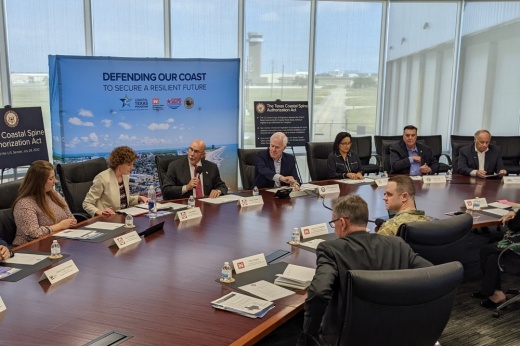U.S. Sen. John Cornyn, R-Austin, met with various officials Oct. 13 at the Lone Star Flight Museum in Clear Lake for a roundtable discussion about the Coastal Texas Study, a yearslong effort by the U.S. Army Corps of Engineers and the Texas General Land Office to plan and design projects to protect Texas’ coast from major storms.
The study calls for projects along Texas' coast from Mexico to Louisiana at a total estimated cost of $28.9 billion, making it the largest undertaking by the Army Corps of Engineers in its 200-plus-year history. Projects include building a series of navigable gates between Galveston Island and the Bolivar Peninsula; a ring of barriers around Galveston Island; sand dunes and beaches along the coast to offer a natural form of defense; and more.
“There’s never been any project this big,” Cornyn said. “This is going to set all sorts of new records.”
The coastal spine, which is the series of gates planned between Galveston Island and the Bolivar Peninsula, will save lives and protect many critical industries that bolster the state’s economy and the nation’s security in the inevitable event of another hurricane, Cornyn said.
In Washington, D.C., legislators pushed Congress to fund the Coastal Texas Study. Last year came the submission of the chief engineer’s report, which made the study’s projects eligible for authorization, Cornyn said.
Over the summer, Cornyn and others introduced the Texas Coastal Spine Authorization Act, which passed in the U.S. Senate on July 28 to make the project eligible for construction. The U.S. House of Representatives is in the midst of passing its own version of the act, and once it does, legislators will work to secure funding for the project and then begin construction, Cornyn said.
Cornyn said securing federal dollars for the project will be a challenge, because it is easier to get money from the federal government after a disaster rather than before one.
“This is a marathon and not a sprint,” he said.
Seabrook Mayor Thom Kolupski said he hopes for urgency in getting the coastal spine and related projects underway.
“If there’s any way we could turn it into a slow jog, it would be much appreciated,” he said.
After Hurricane Ike in 2008, 33% of Seabrook’s homes were destroyed, and 60% were damaged, most of them severely. The city lost businesses, and its economy suffered, Kolupski said.
“The results are devastating,” he said of such storms. “We need help, and we need it as fast as we can get it.”
Kolupski pointed out that, while high, the cost of the coastal spine is a “drop in the bucket” compared to the cost of recovery after a major storm.
Kelly Burks-Copes, project manager of the Coastal Texas Study, said it is expected the coastal spine will save the area $2 for every $1 spent. Still, if the Corps received all the money it needed to fund the coastal spine today, she said it would still take an estimated 18 years to complete all the projects—a fact that surprised Cornyn.
Michael Bechtel is board president of the Gulf Coast Protection District, an entity put together to be the local sponsor of the coastal spine. With the Legislature kicking off in January, the district will be asking the state for $400 million-$500 million to start funding the projects, he said.
Thanks to the legislature, the district has the power to tax residents to help fund the coastal spine, but that is not on the table at the moment, he said.
“We’re not anywhere near looking to do that,” Bechtel said, noting the district is looking for alternative funding sources.
Chris Witte, executive board member of the Texas Chemical Council, said the barrier will be crucial to the region’s petrochemical industry. While plants are built and designed to withstand devastating storms, the homes of the people who work at and support the plants are not. Billions of dollars’ worth of assets will sit idle if plants do not have the people to run them.
“The coastal spine has our full support,” he said.
Rep. Dennis Paul, R-Houston, said he hopes legislators frontload the project to shorten the expected 18-year timeline to complete all projects. Paul, who lives within walking distance of the museum where the roundtable was held, said the coastal spine would help him not have sea water in his front yard during a storm, which illustrates the difference the project will make for everyone in the region.
“I feel confident we’ll be able to get some money out of the Legislature,” he said. “My commitment 100% is to fight for this and get it done.”





